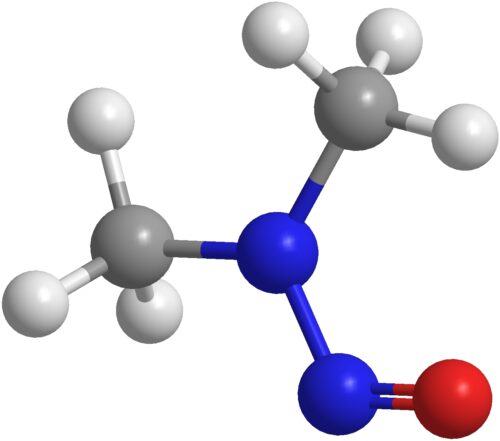AMPAC Analytical has implemented test methods using LC-HRMS and GC-MS to identify trace Nitrosamines in drug substances and drug products.
Stay compliant with the FDA, and get your active pharmaceutical ingredient (API) and drug product tested for NDMA.
NDMA and Nitrosamines are difficult molecules to detect

NDMA
General analytical tests previously used by the industry to release API/DP may not have been able to detect the presence of Nitrosamines. AMPAC Analytical Labs has implemented methodologies to detect this class of impurities using LC-HRMS as well as GC-MS.
Why Test For NDMA Impurities
NDMA and Nitrosamines in general, are genotoxic impurities and have been classified by the U.S. Environmental Protection Agency (EPA) and Food and Drug Administration (FDA) as probable human carcinogens. Nitrosamines, such as N-Nitrosodimethylamine (NDMA), can be found at low levels in numerous items of human consumption, including cured meat, fish, beer, tobacco smoke, and most recently, as an impurity in various pharmaceuticals.
In recent reports, there have been several Angiotensin-II-receptor antagonists, AKA “Sartans”, which have been contaminated with NDMA. The EPA has determined that the maximal admissible concentration of NDMA in drinking water is 7 ng/L.
Test Your Products in Compliance For FDA Guidelines
Pharmaceutical products have been on the news as these products are taken for chronic diseases, medications taken multiple times a day, and in varying dosages. Regulatory agencies are actively involved in addressing the issue by detecting, testing, and quantifying these impurities. New applications, renewal, synthetic route modifications, and sourcing of material modifications can be subject to evaluation for the presence of Nitrosamines.
To view the FDA’s “Control of Nitrosamine Impurities in Human Drugs – Guidance for Industry” PDF document, please click the link below.
Learn More About Genotoxic Impurities
N-Nitrosodimethylamine (NDMA) is a yellow, oily liquid with a faint, characteristic odor. It is an industrial by-product or waste product of several industrial processes, such as the manufacturing of unsymmetrical dimethylhydrazine, which is a component of rocket fuel that requires NDMA for its synthesis. NDMA is found at low levels in numerous items of human consumption, including cured meat, fish, beer, tobacco smoke, and, most recently, as an impurity in various pharmaceuticals. In recent reports, there have been several “sartans” that have been contaminated with NDMA, which is highly toxic, especially to the liver, and is a known carcinogen in lab animals. The EPA classifies NDMA as a probable human carcinogen. The US Environmental Protection Agency has determined that the maximal admissible concentration of NDMA in drinking water is 7 ng/L.
Nitrosamine impurities such as NDMA and NDEA can be analyzed and quantified using gas chromatography or high-performance liquid chromatography coupled with a high-resolution mass spectrometer.
Nitrosamine impurities such as NDMA and NDEA can be quantified using gas chromatography or high-performance liquid chromatography coupled with a high-resolution mass spectrometer.
Nitrosamine impurities such as NDMA and NDEA can be detected at ppb level using gas chromatography coupled with a high-resolution mass spectrometer.
Nitrosamine impurities such as NDMA and NDEA can be analyzed and quantified using gas chromatography or high-performance liquid chromatography coupled with a high-resolution mass spectrometer.
Nitrosamines are a family of carcinogens impurities which are formed by the reaction of secondary amines, amides, carbamates, derivatives of urea with nitrite or other nitrogenous agents. Nitrosamines are classified by the ICH M7 Guideline as Class 1 impurities, also known as mutagenic carcinogens.
- Use of sodium nitrite (NaNO2), or other nitrosating agents.
- Use of contaminated raw materials and intermediates by nitrosamine.
- Degradation processes of starting materials, intermediates, and drug substances. This could potentially occur also during finished product formulation or storage.
- Use of certain contaminated packaging materials

